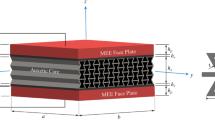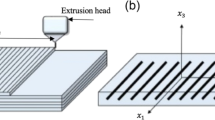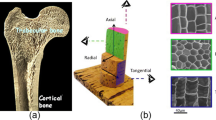Abstract
Two dimensional nature of thin membranes has led to their evolution as an essential component in space structures that demand lighter mass and compact packaging. Origami based folding patterns are used to fold these membranes into compact configurations by introducing plastic deformations along the predetermined fold-lines referred to as creases. Creases have been observed to alter the material state and the mechanical response of highly compacted thin membranes, leading to changes in their deployment behaviour outer space. This paper proposes an idealised connector element based method which introduces rotational stiffness associated with the creases while eliminating the requirement for a large number of small shell elements to capture accurate deployment behaviour. First, an experiment is carried out to quantify the fold-line rotational stiffness of Kapton polyimide film. Then, the technique is implemented in a commercially available finite element package ABAQUS simulating the deployment of a single-folded thin membrane, and is identified to capture in-plane and out-of-plane displacements with a better approximation than the other existing crease modelling techniques. Then the applicability of the proposed technique is validated against a quasi-static deployment experiment of a solar sail model available in the literature. The use of the proposed technique has proven to be qualitatively effective in terms of inducing a quasi-static deployment that achieves fair quantitative agreement as well.














Similar content being viewed by others
References
Abaqus, Analysis User Guide, Dassault Systems, Simulia Crop. Providence, RI (2014)
Andrew, A.C., Philip, B.C., James, J.J., Gregory, R.W., Richard, V.A.: Characterization of creases in polymers for adaptive origami structures. In: ASME 2014 Conference on Smart Materials, Adaptive Structures and Intelligent Systems SMASIS2014, Newport (2014)
Arya, M., Pellegrino, S.: Deployment mechanics of highly compacted thin membrane structures. In: Spacecraft Structures Conference. National Harbor, Maryland, pp. 1–14 (2014). https://doi.org/10.2514/6.2014-1038
Arya, M., Lee, N., Pellegrino, S.: Crease-free biaxial packaging of thick membranes with slipping folds. Int. J. Solids Struct. 108, 24–39 (2017). https://doi.org/10.1016/j.ijsolstr.2016.08.013
Autodesk.: AutoCAD 2021. Autodesk Inc., San Rafael, California (2021)
Cai, J., Ren, Z., Ding, Y., Deng, X., Xu, Y., Feng, J.: Deployment simulation of foldable origami membrane structures. Aerosp. Sci. Technol. 67, 343–353 (2017). https://doi.org/10.1016/j.ast.2017.04.002
Chen, Y., Peng, R., You, Z.: Origami of thick panels. Science 349(6246), 396–400 (2015). https://doi.org/10.1126/science.aab2870
De Focatiis, D.S.A., Guest, S.D.: Deployable membranes designed from folding tree leaves. Philos. Trans. R. Soc. Lond. A Math. Phys. Eng. Sci. 360(1791), 227–238 (2002). https://doi.org/10.1098/rsta.2001.0928
Dharmadasa, B.Y., Jiménez, F.L.: Modeling the effects of creases in an unfolding membrane. In: AIAA Scitech 2021 Forum (2021). https://doi.org/10.2514/6.2021-1258
Dharmadasa, B.Y., McCallum, M.W., Mierunalan, S., Dassanayake, S.P., Mallikarachchi, C.H.M.Y., López Jiménez, F.: Formation of plastic creases in thin polyimide films. J. Appl. Mech. 87(5), 2 (2020). https://doi.org/10.1115/1.4046002
Dias, M.A., Dudte, L.H., Mahadevan, L., Santangelo, C.D.: Geometric mechanics of curved crease origami. Phys. Rev. Lett. (2012). https://doi.org/10.1103/PhysRevLett.109.114301
Dupont, Dupont Kapton Summary of Properties (2021)
Eriksson, A., Faroughi, S.: Quasi-static inflation simulations based on co-rotational triangular space membrane elements. Int. J. Struct. Stab. Dyn. 13(3), 1250067 (2013). https://doi.org/10.1142/S0219455412500678
Faroughi, S., Eriksson, A.: Co-rotational formulation for dynamic analysis of space membranes based on triangular elements. Int. J. Mech. Mater. Des. 13, 229–241 (2017). https://doi.org/10.1007/s10999-015-9326-x
Gruber, P., Häuplik, S., Imhof, B., Özdemir, K., Waclavicek, R., Perino, M.A.: Deployable structures for a human lunar base. Acta Astronaut. 61(1), 484–495 (2007). https://doi.org/10.1016/j.actaastro.2007.01.055
Guest, S.D.: Deployable Structures: Concepts and Analysis. Ph.D. thesis, University of Cambridge (1994)
Guest, S., Pellegrino, S.: Inextensional wrapping of at membranes. In: First International Seminar Structure and Morphology. Morphol, pp 203–215 (1992)
Han, H., Sorokin, V., Tang, L., Cao, D.: Lightweight origami isolators with deployable mechanism and quasi-zero-stiffness property. Aerosp. Sci. Technol. 121, 107319 (2022). https://doi.org/10.1016/j.ast.2021.107319
Hossain, N.M.A., Woo, K., Jenkins, C.H.: Nonlinear material response of systematically creased membranes. In: 47th AIAA/ASME/ASCE/AHS/ASC Structures, Structural Dynamics, and Materials Conference, Structures, Structural Dynamics, and Materials Conference. New Port, Rhode (2006)
Hu, X., Gong, S.: Flexibility influence on passive stability of a spinning solar sail. Aerosp. Sci. Technol. 58, 60–70 (2016). https://doi.org/10.1016/j.ast.2016.08.005
Lechenault, F., Thiria, B., Adda-Bedia, M.: Mechanical response of a creased sheet. Phys. Rev. Lett. 112(24), 244301 (2014). https://doi.org/10.1103/PhysRevLett.112.244301
Lichodziejewski, D., Derbès, B., Slade, K., Mann, T.: Vacuum deployment and testing of a 4-quadrant scalable inflatable rigidizable solar sail system. In: 46th AIAA/ASME/ASCE/AHS/ASC Structures, Structural Dynamics and Materials Conference. Austin (2005)
Liu, C., Shi, Y.: Comprehensive structural analysis and optimization of the electrostatic forming membrane reflector deployable antenna. Aerosp. Sci. Technol. 53, 267 (2016). https://doi.org/10.1016/J.AST.2016.03.026
Liu, K., Paulino, G.H.: Nonlinear mechanics of non-rigid origami: An efficient computational approach. Proc. R. Soc. A Math. Phys. Eng. Sci. (2017). https://doi.org/10.1098/rspa.2017.0348
Liyanage, P., Gangasudan, N., Mallikarachchi, H.: Modified spiral folding pattern for deployable membranes. Aerosp. Sci. Technol. 117, 106926 (2021). https://doi.org/10.1016/j.ast.2021.106926
Mallikarachchi, H.M.Y.C., Pellegrino, S.: Quasi-static folding and deployment of ultra thin composite tape-spring hinges. J. Spacecr. Rocket. 48(1), 187–198 (2011). https://doi.org/10.2514/1.47321
Melancon, D., Gorissen, B., García-Mora, C.J., Hoberman, C., Bertoldi, K.: Multistable inflatable origami structures at the metre scale. Nature 592, 545–550 (2021). https://doi.org/10.1038/s41586-021-03407-4
Miura, K.: Method of packaging and deployment of large membranes. In: Proceedings of the 31st Congress of the International Astronautical Federation IAF-80-A 31. Tokyo, pp. 1–10 (1980)
Miura, K., Pellegrino, S.: Forms and Concepts for Lightweight Structures. Cambridge University Press, Cambridge (2020)
NASA. Thin-Films with Integrated Structural and Functional Elements. https://technology.nasa.gov/patent/LAR-TOPS-203 (2015)
Okuizumi, N., Yamamoto, T.: Centrifugal deployment of membrane with spiral folding: experiment and simulation. J. Space Eng. 1, 41–50 (2009). https://doi.org/10.1299/spacee.2.41
Papa, A., Pellegrino, S.: Systematically creased thin-film membrane structures. J. Spacecr. Rocket. 45(1), 10–18 (2008). https://doi.org/10.2514/1.18285
Ridenoure, R.W., Munakata, R., Wong, S.D., Diaz, A., Spencer, D.A., Stetson, D.A., Betts, B., Plante, B.A., Foley, J.D., Bellardo, J.M.: Testing the lightsail program: advancing solar sailing technology using a cubesat platform. JoSS 5(2), 531–550 (2016)
Schenk, M.: Folded Shell Structures. Ph.D. thesis, University of Cambridge (2011)
Seefeldt, P.: A stowing and deployment strategy for large membrane space systems on the example of Gossamer-1. Adv. Space Res. 60(6), 1345–1362 (2017). https://doi.org/10.1016/j.asr.2017.06.006
Shi, F., Wang, Y.: Modelling crease recovery behaviour of woven fabrics. J. Text. Inst. 100, 218–222 (2009)
Sickinger, C., Breitbach, E.: Ultra-lightweight deployable space structures. In: 4th International Conference on Thin-Walled Structures. Loughborough, England (2005)
Sleight, D., Michii, Y., Lichodziejewski, D., Derbes, B., Mann, T., Slade, K., Wang, J.: Finite element analysis and test correlation of a 10-meter inflation-deployed solar sail. In: 46th AIAA/ASME/ASCE/AHS/ASC Structures, Structural Dynamics and Materials Conference. Austin (2005). https://doi.org/10.2514/6.2005-2121
Spencer, D.A., Johnson, L., Long, A.C.: Solar sailing technology challenges. Aerosp. Sci. Technol. 93, 105276 (2019). https://doi.org/10.1016/j.ast.2019.07.009
The Mathworks, Inc., Natick, Massachusetts, MATLAB version 9.3.0.713579 (R2017b) (2017)
Tomohiro, T.: Rigid-foldable thick origami. Origami 5, 253–264 (2011)
Wang, W., Qiu, X.: Coupling of creases and shells. J. Appl. Mech. 85(1), 011009 (2017). https://doi.org/10.1115/1.4038470
Wei, Z.Y., Guo, Z.V., Dudte, L., Liang, H.Y., Mahadevan, L.: Geometric mechanics of periodic pleated origami. Phys. Rev. Lett. 110, 215501 (2013). https://doi.org/10.1103/PhysRevLett.110.215501
Wilson, L.: Analysis of Packaging and Deployment of Ultralight Space Structures. Ph.D. Thesis, California Institute of Technology (2017). https://doi.org/10.7907/Z9B27S96
Zhang, L., Dong, K., Lu, M., Zhang, H.: A wrinkling model for pneumatic membranes and the complementarity computational framework. Comput. Mech. 65, 119–134 (2020). https://doi.org/10.1007/s00466-019-01755-7
Zirbel, S.A., Lang, R.J., Thomson, M.W., Sigel, D.A., Walkemeyer, P.E., Trease, B.P., Magleby, S.P., Howell, L.L.: Accommodating thickness in origami-based deployable arrays. J. Mech. Des. 135(11), 111005 (2013). https://doi.org/10.1115/1.4025372
Acknowledgements
This work has been supported by Ministry of Science Technology and Research, Sri Lanka under Indo-Sri Lanka Research Grant MSTR/TRD/AGR/3/02/09 and Senate Research Committee of University of Moratuwa, Sri Lanka under top up grant SRC/TP/2017/09. S. H. Upadhyay wishes to acknowledge the financial assistance of Department of Science and Technology, Government of India, under Indo-Sri Lanka research Grant DST/INT/SL/P-27/2016.
Author information
Authors and Affiliations
Corresponding author
Ethics declarations
Conflict of interest
The authors declare no potential conflicts of interest with respect to the research and/or publication of this article.
Additional information
Publisher's Note
Springer Nature remains neutral with regard to jurisdictional claims in published maps and institutional affiliations.
Rights and permissions
Springer Nature or its licensor holds exclusive rights to this article under a publishing agreement with the author(s) or other rightsholder(s); author self-archiving of the accepted manuscript version of this article is solely governed by the terms of such publishing agreement and applicable law.
About this article
Cite this article
Mierunalan, S., Dassanayake, S.P., Mallikarachchi, H.M.Y.C. et al. Simulation of ultra-thin membranes with creases. Int J Mech Mater Des 19, 73–94 (2023). https://doi.org/10.1007/s10999-022-09617-6
Received:
Accepted:
Published:
Issue Date:
DOI: https://doi.org/10.1007/s10999-022-09617-6




